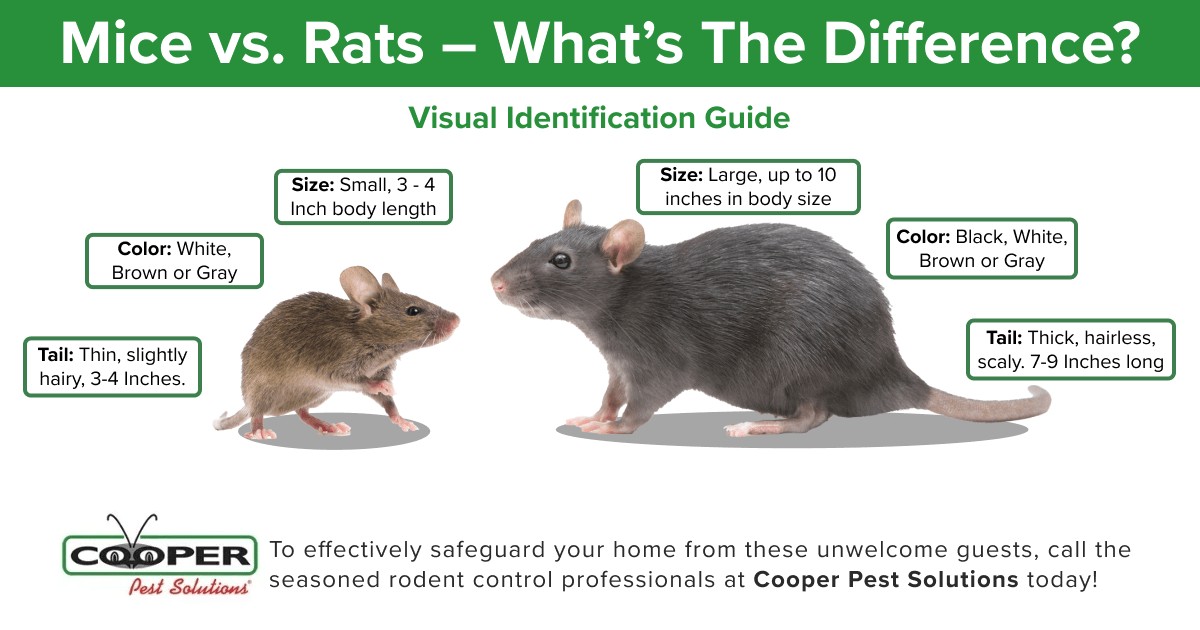Rats and mice, both belonging to the rodent family, often get mistaken for one another. Their similar appearances and potential to cause damage when they invade homes contribute to this confusion. However, understanding whether you’re dealing with a rat or a mouse infestation is crucial for effective pest management. Being able to distinguish a rat compared to a mouse can significantly aid in predicting their behavior and implementing the most appropriate control strategies. This guide from compare.edu.vn will highlight the key differences between these common household pests.
Size Difference: Rats Tower Over Mice
One of the most immediately noticeable differences between rats and mice is their size. Rats are considerably larger than mice. A typical house mouse measures between two to four inches in body length. In stark contrast, the Norway rat, a common species, can grow to a substantial seven to nine inches long. This size difference is a primary indicator when trying to identify which rodent you’re encountering.
While the size disparity is clear in adults, identifying juveniles can be trickier. A young rat might appear deceptively similar in size to a fully grown mouse. If you’re uncertain about rodent identification, especially when observing smaller specimens, consulting a pest control expert can provide definitive answers.
Physical Appearance: Spotting the Distinctions
 Differences in physical appearance between a rat and a mouse
Differences in physical appearance between a rat and a mouse
Although both rats and mice share similar fur coloration, closer inspection reveals distinct physical characteristics that set them apart. From nose to tail, these visual differences are key to distinguishing between a rat compared to a mouse:
Snout Shape
Examine the shape of the snout. Mice possess a more pointed, triangular nose, giving them a delicate appearance. Rats, on the other hand, have a blunter, less sharply defined nose. This difference in snout shape is a subtle but reliable visual cue.
Ear Size and Shape
Observe their ears. Mice are characterized by relatively large, floppy ears in proportion to their body size. These prominent ears are a defining feature of mice. Conversely, rats have smaller ears that are closer to their head and less conspicuous, contributing to a more streamlined look.
Tail Characteristics
Pay attention to the tail. Rats have tails that are noticeably longer, thicker, and appear hairless and scaly. In comparison, mice have thinner, slightly hairy tails that are also proportionally shorter relative to their body length. The rat’s tail often appears coarse and substantial, unlike the more delicate tail of a mouse.
Behavioral Differences: Actions Speak Louder Than Size
Beyond physical attributes, rats and mice exhibit distinct behavioral patterns. Even though they are both rodents, their behaviors diverge in ways that can influence infestation management. Recognizing these behavioral differences can be as important as visual identification when dealing with a rodent problem.
Bravery vs. Caution
Mice are generally bolder and more inquisitive than rats. Despite their smaller size, mice are known for their curiosity and willingness to explore new environments, including traps. This exploratory nature can sometimes make mice easier to trap initially. Rats, however, are typically more cautious and neophobic, meaning they fear new things.
Trapping Challenges
Rats are notoriously harder to trap than mice due to their cautious nature. They are wary of new objects and take a considerable amount of time to investigate anything unfamiliar in their surroundings. This cautious behavior makes them less likely to readily enter traps, requiring more strategic and patient trapping approaches.
Hiding Prowess
Mice excel at hiding in incredibly small spaces. Their diminutive size allows them to squeeze through tiny cracks and holes, granting them access to areas of your home that might seem impenetrable to larger pests. This ability to exploit small openings makes comprehensive sealing of entry points critical in mouse control.
Climbing Preferences
Rats, with the exception of roof rats, generally prefer to nest in the lower levels of buildings. They are less inclined to climb and typically establish their habitats in basements or ground floors. Mice, in contrast, are adept climbers and readily inhabit upper areas, including attics. Their climbing ability means infestations can occur throughout a building, from the basement to the attic.
Is a Rat Infestation Worse Than Mice? Understanding the Risks
Regardless of whether you’re dealing with rats or mice, any rodent infestation in your home poses significant risks. Both types of rodents can cause substantial property damage and pose health hazards. The problems associated with both rats and mice include:
- Gnaw Damage: Both rodents constantly gnaw to keep their teeth trimmed, leading to damage to walls, furniture, and other household items.
- Food Contamination: Rodents contaminate food sources and preparation areas with their droppings, urine, and fur, posing health risks.
- Insulation Damage: They can chew through insulation in walls and attics, reducing energy efficiency and causing structural issues.
- Electrical Hazards: Rodents frequently gnaw on electrical wires, increasing the risk of short circuits and electrical fires.
- Disease Transmission: Both rats and mice can transmit various diseases, some of which can be serious or even fatal to humans.
Finding any rodent in your home is a cause for concern, highlighting the need for prompt and effective action to mitigate these risks. Understanding the specific type of rodent you’re facing – Rat Compared To Mouse – is the first step in addressing the problem effectively.